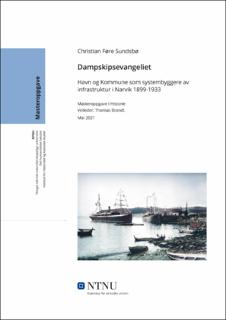| dc.contributor.advisor | Brandt, Thomas. | |
| dc.contributor.author | Sundsbø, Christian Føre. | |
| dc.date.accessioned | 2021-11-03T18:20:08Z | |
| dc.date.available | 2021-11-03T18:20:08Z | |
| dc.date.issued | 2021 | |
| dc.identifier | no.ntnu:inspera:80289343:26486980 | |
| dc.identifier.uri | https://hdl.handle.net/11250/2827710 | |
| dc.description.abstract | Hensikten med denne oppgaven er å se på Narviks tidlige byutvikling fra 1899 til 1933 med større fokus på Havnen og Kommunen. Tidligere historisk forskning om både norsk urbaniseringshistorie og Narviks utvikling har fokusert på jernbanens påvirkning og statens samarbeid med kommunene. Denne oppgaven fokuserer i stedet på Havnens rolle i byutviklingen i Narvik, og hvordan nødvendig infrastruktur innenfor samferdsel, handel og transport ble bygget.
For å se institusjonen Havnevesenet som en historisk aktør brukes systemteori. Det teoretiske rammeverket av store teknologiske systemer har tidligere blitt brukt innen historiefaget for å se hvordan nettverk av større private industrier har blitt bygget. Denne oppgaven fokuserer mer på offentlige institusjoner, som Narvik Havnevesen- og Kommune, og hvordan de forholdt seg til departementer og komiteer. Gjennom diskursanalyse av korrespondansen mellom de ulike partene etableres et mønster av Havnens rolle og hvordan denne rollen endret seg over tid i forhold til Kommunen og Staten.
Oppgaven viser hvordan Havnen tok handling som systembygger av infrastruktur i fraværet av noen betydelig offentlig økonomisk støtte. I tillegg viser den hvordan det lokale samfunnet motiverte denne ekspansjonen, og hvordan Kommunen med andre lokale institusjoner samarbeidet med Havnen økonomisk for egen vinning. Med de lokale samfunnskreftene som motivasjon og selvstendig systembygging av infrastruktur var Narviks rolle som by annerledes enn hva tidligere forskning har konkludert med. Narviks lokale identitet som sentrum for Ofoten startet med byens grunnleggelse i 1902. Dette bevises gjennom datidens tidlige debatt hvor ønsker om bedre forbindelser mellom by- og omland var gjengående tema. Ved å vektlegge Havnens rolle bidrar oppgaven å nyansere både Narviks historie, men også norsk urbaniseringshistorie, hvor jernbanen har fått mest oppmerksomhet i tidligere undersøkelser. | |
| dc.description.abstract | This thesis will explore the city of Narvik’s early development from 1899 to 1933 with more emphasis on the Harbour Authority’s relationship to the local city government. Previous historical research on both Norwegian urbanisation history and Narvik’s development have focused on the effects of the railway and related cooperation between local governments and the state. This thesis focuses instead on the Harbour Authority’s role in Narvik’s city development and how important infrastructure in general transport and communications was built.
To analyse the Harbour as a historical actor the thesis uses the theoretical framework of large technological systems. This has previously been used within historical research mostly to document the expansion of private cooperation networks. This thesis analyses public institutions instead, such as the Harbour Authority and the local city government, and their respective relationships to state departments and commissions. Using discourse analysis of correspondence between the different actors a pattern is established of the Harbour’s role and how this role changed throughout the period.
This thesis shows how the local Harbour Authority acted as a system builder of infrastructure in absence of any significant economic support. In addition, it illustrates how the local community motivated this expansion, and how the local city municipality along with other local institutions cooperated with the Harbour economically for their own personal gains. With the local social communal factors serving as motivation for system building of infrastructure, Narvik’s role as a city was different from what previous research has concluded with. Narvik’s local identity as the centre of Ofoten started with the city’s foundation in 1902. Such is proven through the discourse in the debate wanting to improve connections between the city and the local district. By emphasising the Harbour’s role, this thesis helps diversify both Narvik’s history, but also Norwegian urbanisation history where the railway has previously gotten the most attention. | |
| dc.language | nob | |
| dc.publisher | NTNU | |
| dc.title | Dampskipsevangeliet - Havn og Kommune som systembyggere av infrastruktur i Narvik 1899-1933 | |
| dc.type | Master thesis | |
